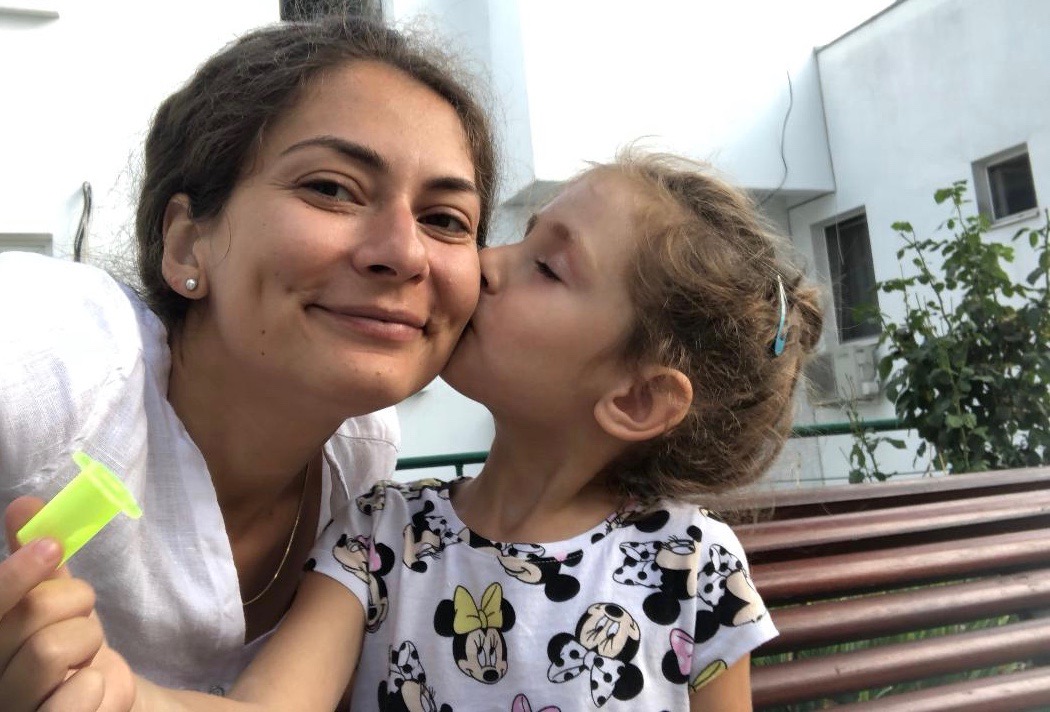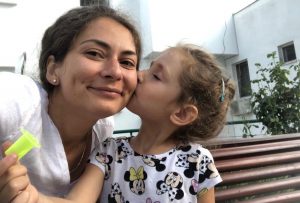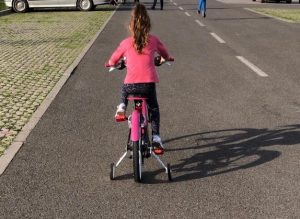Romanian Mom Leads Nationwide Effort to Get Spinraza Funded for Daughter and All SMA Patients

Bogdana Patrascu and her daughter, Alberta, who has made remarkable progress with Spinraza. (Photos courtesy of Bogdana Patrascu)
Bogdana Patrascu will never forget the day she learned that her then-3-year-old daughter, Alberta, had spinal muscular atrophy (SMA).
The news came in a March 2016 phone call from Alberta’s pediatric neurologist, as Patrascu — a radiologist in Timisoara, Romania — was driving home from work. She had taken Alberta to the neurologist because the girl was having difficulty walking and controlling other muscles.
The most devastating thing the neurologist told her — which thankfully turned out to be misinformation — was that no treatment for SMA was available or in the pipeline.
“At home, I gathered my little girl in my arms, knowing she would lose her ability to walk in a few years, and that I could not do anything to stop the evolution of this terrible, rare, genetic, neurodegenerative disease,” Patrascu said in an interview in Romania’s capital, Bucharest.
Shortly after Alberta’s diagnosis, Patrascu would learn from social media that a treatment was in the pipeline — Biogen’s Spinraza (nusinersen). She resolved that upon Spinraza’s approval, Romanian healthcare authorities would make it available to the country’s 140 or so SMA patients, despite its retail cost of $750,000 for the first year of treatment and $375,000 each year thereafter.
Patrascu spoke to SMA News Today in Bucharest during the May 17-19 membership meeting of Eurordis, a Paris-based rare disease coalition with members in all 28 European Union (EU) member countries and beyond.
Convinced that a national SMA patient association would be the key to a successful campaign, Patrascu persuaded a regional group she had joined to expand throughout Romania. That organization is known as the National Association for Helping People Suffering from Spinal Muscular Atrophy.
The campaign took constant drum-beating about the need for Spinraza, awareness-building conferences, sympathetic politicians, and SMA community protests. But in October 2018, a Romanian child became the first in the country to receive the injection.
Health officials decided that the country’s 80 children with SMA would receive Spinraza before the 60 adults. Fifty children, including Alberta, are now on the therapy, with the other 30 waiting for the government to allocate more funds.
Spinraza’s FDA approval a ‘miracle’
Patrascu said she’s amazed at what Spinraza has done for Alberta, who has type 3 SMA. Although it’s the least severe form, type 3 can still lead to confinement to a wheelchair.
“All I wanted was for Spinraza to stop the progression of the disease,” Patrascu said. “But my little girl is now managing to climb the stairs alone with the help of the banister, to jump, and to pedal a bicycle with training wheels. The fact that she is getting new motor skills is wonderful.”
The first sign that Spinraza could actually become a reality for Romanian patients was its initial approval by the U.S. Food and Drug Administration (FDA) in December 2016. Patrascu called that approval “a miracle — the most beautiful Christmas present imaginable,” though she knew even then that Spinraza’s availability in Romania was still a long way off.
“A lot of people said I was crazy to think that Romania, a developing country, would buy such an expensive medicine,” she said. “I responded that I was going to do everything possible to achieve it, or die trying.”
One by one, the pieces fell into place for Romanian SMA patients to obtain Spinraza, although not nearly as quickly as Patrascu and other SMA activists had hoped.
The European Medicines Agency (EMA), the EU’s drug-regulating body, approved Spinraza in June 2017. This opened the door to Spinraza’s eventual availability in Romania, an EU member state.
A few weeks later at Romania’s first national SMA conference, Biogen representatives — who had been invited to the gathering — pledged to introduce Spinraza to the country. A well-known politician also got behind the effort.
“This senator stood up and invited us to come to Parliament to talk loudly and forcefully about our needs and our dreams, so we could get as much support as possible from the Romanian health authorities,” Patrascu said.
Next step: SMA newborn screening
For nine months, little happened; then there was a spurt. In April 2018, Romanian regulators approved Spinraza for national healthcare system reimbursement, and that May, the Health Ministry signed off on the decision.
But the euphoria evaporated when the government dragged its feet on allocating funding for Spinraza. In May, Patrascu began organizing demonstrations outside the ministry’s headquarters and at other locations, demanding financing. Finally, on Oct. 4, the first Romanian SMA patient received Spinraza in a direct injection to the spinal cord.
Patrascu said she knew the protests were risky, but she didn’t want the SMA community to wait any longer.
“I was the one who challenged the participants to take part, and I thank those who trusted me and participated,” she said. As a doctor whose skills would have been welcomed elsewhere in the EU, she added, “I could have gone to another country to work where it was easier to get Spinraza, but I wanted the drug in Romania for all SMA patients.”
Now that Spinraza is available, Patrascu plans another campaign: the inclusion of SMA on the list of diseases for which all newborns are screened. This would allow doctors to immediately diagnose the condition, dramatically improving prospects of babies with the disorder.
Patrascu said she’s also excited about another treatment for SMA whose FDA approval is imminent: Zolgensma (onasemnogene abeparvovec), a gene therapy developed by Novartis‘ subsidiary AveXis that replaces the faulty SMN1 gene with a copy that works.
“The promise of this new approach is that children born with SMA will be able to be treated before they develop symptoms, and not have to die of this disease,” she said. “It is our job — as doctors, researchers, members of patient associations, and political decision-makers — to make sure this promise is realized. Together we can defeat SMA.”










